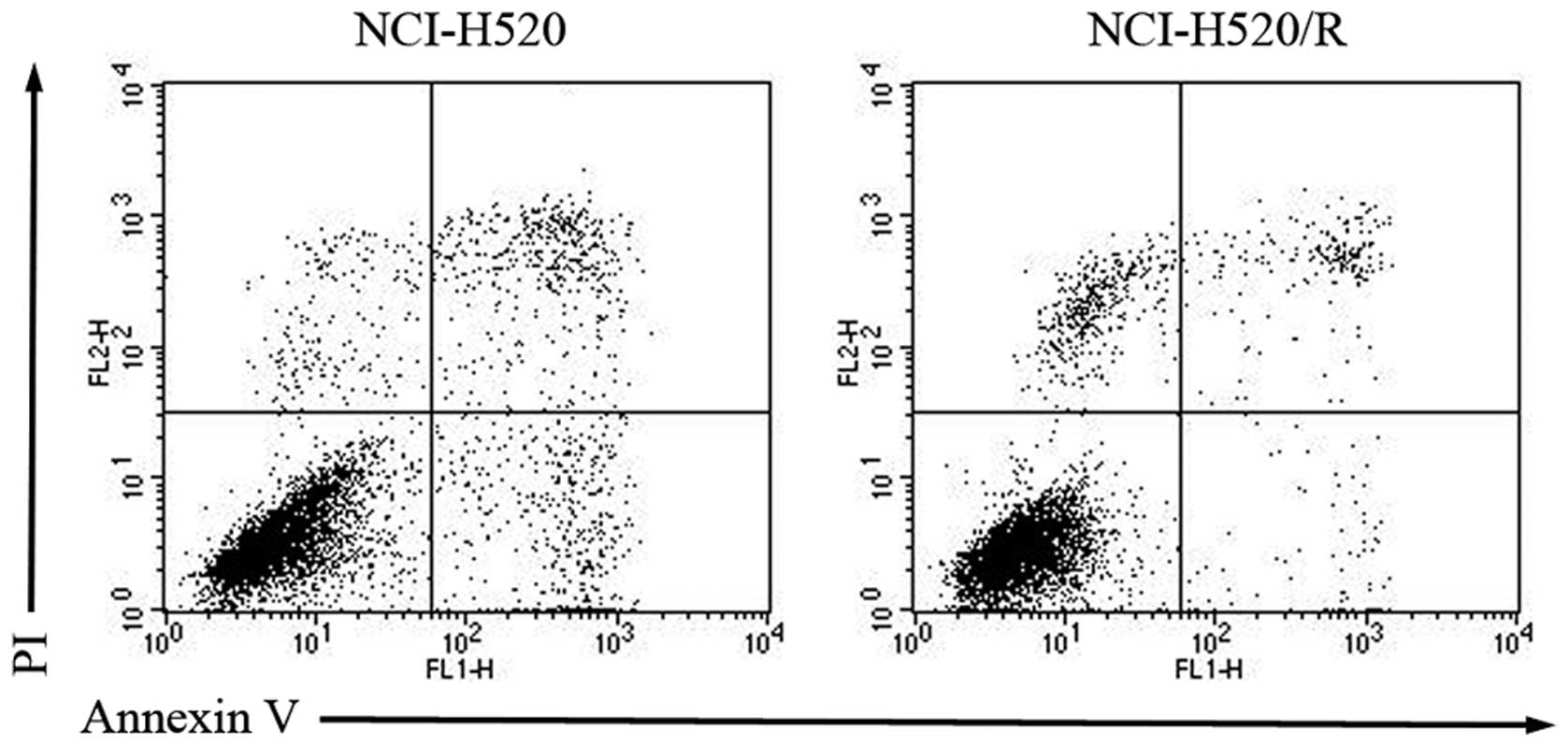|
1
|
Evans M: Lung cancer: Needs assessment,
treatment and therapies. Br J Nurs. 22:S15–S16. S18S20–12. 2013.
View Article : Google Scholar : PubMed/NCBI
|
|
2
|
Koh PK, Faivre-Finn C, Blackhall FH and De
Ruysscher D: Targeted agents in non-small cell lung cancer (NSCLC):
clinical developments and rationale for the combination with
thoracic radiotherapy. Cancer Treat Rev. 38:626–640. 2012.
View Article : Google Scholar
|
|
3
|
Thomas A, Rajan A, Lopez-Chavez A, Wang Y
and Giaccone G: From targets to targeted therapies and molecular
profiling in non-small cell lung carcinoma. Ann Oncol. 24:577–585.
2013. View Article : Google Scholar :
|
|
4
|
Bartel DP: MicroRNAs: target recognition
and regulatory functions. Cell. 136:215–233. 2009. View Article : Google Scholar : PubMed/NCBI
|
|
5
|
Asli NS, Pitulescu ME and Kessel M:
MicroRNAs in organogenesis and disease. Curr Mol Med. 8:698–710.
2008. View Article : Google Scholar : PubMed/NCBI
|
|
6
|
Gangaraju VK and Lin H: MicroRNAs: key
regulators of stem cells. Nat Rev Mol Cell Biol. 10:116–125. 2009.
View Article : Google Scholar : PubMed/NCBI
|
|
7
|
Carthew RW and Sontheimer EJ: Origins and
Mechanisms of miRNAs and siRNAs. Cell. 136:642–655. 2009.
View Article : Google Scholar : PubMed/NCBI
|
|
8
|
Zhang B, Pan X, Cobb GP and Anderson TA:
microRNAs as oncogenes and tumor suppressors. Dev Biol. 302:1–12.
2007. View Article : Google Scholar
|
|
9
|
Lowery AJ, Miller N, McNeill RE and Kerin
MJ: MicroRNAs as prognostic indicators and therapeutic targets:
potential effect on breast cancer management. Clin Cancer Res.
14:360–365. 2008. View Article : Google Scholar : PubMed/NCBI
|
|
10
|
Gaur A, Jewell DA, Liang Y, et al:
Characterization of microRNA expression levels and their biological
correlates in human cancer cell lines. Cancer Res. 67:2456–2468.
2007. View Article : Google Scholar : PubMed/NCBI
|
|
11
|
Blower PE, Verducci JS, Lin S, et al:
MicroRNA expression profiles for the NCI-60 cancer cell panel. Mol
Cancer Ther. 6:1483–1491. 2007. View Article : Google Scholar : PubMed/NCBI
|
|
12
|
Xie L, Song X, Yu J, et al: Solute carrier
protein family may involve in radiation-induced radioresistance of
non-small cell lung cancer. J Cancer Res Clin Oncol. 137:1739–1747.
2011. View Article : Google Scholar : PubMed/NCBI
|
|
13
|
Altomare DA and Testa JR: Perturbations of
the AKT signaling pathway in human cancer. Oncogene. 24:7455–7464.
2005. View Article : Google Scholar : PubMed/NCBI
|
|
14
|
Sambade MJ, Camp JT, Kimple RJ, Sartor CI
and Shields JM: Mechanism of lapatinib-mediated radiosensitization
of breast cancer cells is primarily by inhibition of the
Raf>MEK>ERK mitogen-activated protein kinase cascade and
radiosensitization of lapatinib-resistant cells restored by direct
inhibition of MEK. Radiother Oncol. 93:639–644. 2009. View Article : Google Scholar : PubMed/NCBI
|
|
15
|
Stuschke M, Sak A, Wurm R, et al:
Radiation-induced apoptosis in human non-small-cell lung cancer
cell lines is secondary to cell-cycle progression beyond the
G2-phase checkpoint. Int J Radiat Biol. 78:807–819. 2002.
View Article : Google Scholar : PubMed/NCBI
|
|
16
|
Panganiban RA, Snow AL and Day RM:
Mechanisms of radiation toxicity in transformed and non-transformed
cells. Int J Mol Sci. 14:15931–15958. 2013. View Article : Google Scholar : PubMed/NCBI
|
|
17
|
Wagner EF and Nebreda AR: Signal
integration by JNK and p38 MAPK pathways in cancer development. Nat
Rev Cancer. 9:537–549. 2009. View
Article : Google Scholar : PubMed/NCBI
|
|
18
|
Ghosh S, Kumar A, Tripathi RP and Chandna
S: Connexin-43 regulates p38-mediated cell migration and invasion
induced selectively in tumour cells by low doses of γ-radiation in
an ERK-1/2-independent manner. Carcinogenesis. 35:383–395. 2014.
View Article : Google Scholar
|
|
19
|
Williams TM, Flecha AR, Keller P, et al:
Cotargeting MAPK and PI3K signaling with concurrent radiotherapy as
a strategy for the treatment of pancreatic cancer. Mol Cancer Ther.
11:1193–1202. 2012. View Article : Google Scholar : PubMed/NCBI
|
|
20
|
Marampon F, Gravina GL, Di Rocco A, et al:
MEK/ERK inhibitor U0126 increases the radiosensitivity of
rhabdomyosarcoma cells in vitro and in vivo by downregulating
growth and DNA repair signals. Mol Cancer Ther. 10:159–168. 2011.
View Article : Google Scholar : PubMed/NCBI
|
|
21
|
He Z, Jia C, Feng S, et al: TRPC5 channel
is the mediator of neurotrophin-3 in regulating dendritic growth
via CaMKIIα in rat hippocampal neurons. J Neurosci. 32:9383–9395.
2012. View Article : Google Scholar : PubMed/NCBI
|
|
22
|
Quadrato G and Di Giovanni S: Gatekeeper
between quiescence and differentiation: p53 in axonal outgrowth and
neurogenesis. Int Rev Neurobiol. 105:71–89. 2012.PubMed/NCBI
|
|
23
|
Skaper SD: The neurotrophin family of
neurotrophic factors: an overview. Methods Mol Biol. 846:1–12.
2012.PubMed/NCBI
|
|
24
|
Murase S: Signal transducer and activator
of transcription 3 (STAT3) degradation by proteasome controls a
developmental switch in neurotrophin dependence. J Biol Chem.
288:20151–20161. 2013. View Article : Google Scholar : PubMed/NCBI
|
|
25
|
Patapoutian A and Reichardt LF: Trk
receptors: Mediators of neurotrophin action. Curr Opin Neurobiol.
11:272–280. 2001. View Article : Google Scholar : PubMed/NCBI
|
|
26
|
Alsina FC, Ledda F and Paratcha G: New
insights into the control of neurotrophic growth factor receptor
signaling: implications for nervous system development and repair.
J Neurochem. 123:652–661. 2012. View Article : Google Scholar : PubMed/NCBI
|















